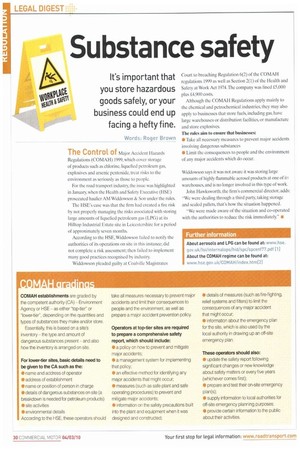U 1
Page 30

If you've noticed an error in this article please click here to report it so we can fix it.
COMAH establishments are graded by the competent authority (CA) Environment Agency or HSE as either "top-tier" or "lower-tier", depending on the quantities and types of substances they make and/or store.
Essentially, this is based on a site's inventory the type and amount of dangerous substances present and also how the inventory is arranged on site.
For lower-tier sites. basic details need to be given to the CA such as the:
• name and address of operator • address of establishment • name or position of person in charge • details of dangerous substances on site (a breakdown is needed for petroleum products) • site activities • environmental details According to the HSE, these operators should take all measures necessary to prevent major accidents and limit their consequences to people and the environment, as well as prepare a major accident prevention policy.
Operators at top-tier sites are required to prepare a comprehensive safety report, which should include: • a policy on now to prevent and mitigate major accidents; • a management system for implementing that policy; • an effective method for identifying any major accidents that might occur; • measures (such as safe plant and safe operating procedures) to prevent and mitigate major accidents; • information on the safely precautions built into the plant and equipment when it was designed and constructed;
• details of measures (such as fire-fighting, relief systems and filters) to limit the consequences of any major accident that might occur;
• information about the emergency plan for the site, which is also used by the local authority in drawing up an off-site emergency plan.
These operators should also: • update the safety report following significant changes or new knowledge about safety matters or every f we years (whichever comes first); • prepare and test their on-site emergency plan(s);
• supply information to local authorities for off-site emergency planning purposes:
• provide certain information to the public about their activities.
































































































































